Like our earlier reports on the combat situation in Ukraine, this article takes stock of the recent developments on the battlefield based on open-source information. Meduza has condemned Russia’s invasion of Ukraine from the very start, and our detailed military analyses are part of our commitment to objective reporting on a war we firmly oppose.
Our map is based exclusively on open-source photos and videos, most of them posted by eyewitnesses on social media. We collect available evidence and determine its geolocation markers, adding only the photos and videos that clear this process. Meduza doesn’t try to track the conflict in real time; the data reflected on the map are typically at least 48 hours old.Key updates as of October 6, 2025
Over the last month, the Ukrainian Armed Forces (AFU) have succeeded in slowing the Russian army’s advance in central Donbas. However, this achievement has come at a steep cost. In August, Ukraine redeployed significant forces from other fronts to reinforce defenses around Russia’s breakthrough between Pokrovsk and Kostyantynivka, leaving other sectors more vulnerable. For example, Russian troops have advanced toward Sloviansk along both banks of the Siverskyi Donets River, capturing the Kreminna Forests — an area the AFU had held since the fall of 2022. Meanwhile, another Russian force is advancing almost unopposed westward along the Dnipropetrovsk–Zaporizhzhia regional border. This is in addition to smaller-scale crises in Ukrainian defenses near Orikhiv, south of Zaporizhzhia, and around Kupyansk in the eastern Kharkiv region.
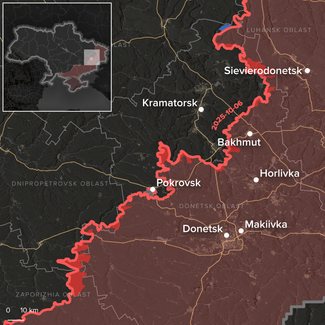
Russia’s breakthrough near Dobropillia
The situation along the front line between Pokrovsk and Kostyantynivka has become somewhat clearer in recent weeks. In August and early September, only a handful of videos from this area were published, mostly showing Ukrainian counterattacks against Russian units that had penetrated deep behind AFU lines. However, geolocated footage now allows for a more complete chronology of the operation and offers a better sense of the current front line — though this remains difficult, since in reality, there’s no continuous “line” as such.
In early August, Russian units from the 51st Army advanced approximately 20 kilometers (12 miles) into Ukrainian defenses between the villages of Nykanorivka and Volodymyrivka, reaching the Dobropillia–Kramatorsk road. Russian forces were also spotted on the northeastern outskirts of Dobropillia.
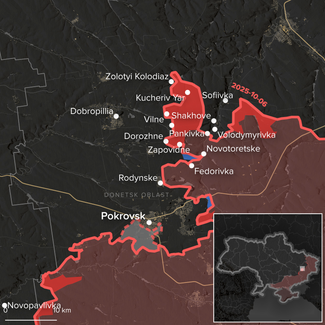
By mid-August, the AFU had brought in reserves to the Dobropillia area from several other areas — primarily from the Sumy region, but also from positions near Kupyansk, Chasiv Yar, and eastern Dnipropetrovsk. These reinforcements enabled Ukrainian forces to push Russian troops back from the Dobropillia–Kramatorsk road. However, attempts to cut off the Russian salient entirely — through strikes on Nykanorivka and Novotroitske on the western flank and Pankivka on the eastern — were unsuccessful.
Russia also brought reinforcements to the area. Initially, the 51st Army — which had previously concentrated most of its forces east of Pokrovsk, around Rodynske — sent additional units to strengthen the neck of the breakthrough. Then, elements of the 20th Motor Rifle Division, which had been advancing toward Kostyantynivka from the southwest, were redeployed further east to Novotroitske, where Ukrainian forces had broken through. Finally, in September, at least four marine brigades were deployed to the breakthrough area near Dobropillia, brought in from the Sumy region and other reserve formations.
By early October, Russian forces had likely stabilized the base of the breakthrough. Ukrainian sources published videos showing Russian troops in Dorozhne, west of Nykanorivka, and in Nove Shakhove, further to the north. However, Ukrainian sources insist that the AFU later counterattacked again and retook both Dorozhne and Novе Shakhove — though there’s no visual confirmation of this, just as there’s none to confirm that Zapovidne has been recaptured. On the eastern flank, Russian marine brigades advanced toward Shakhove and Sofiivka. If these villages are captured, the 51st Army’s positions will no longer be exposed on that side.
At the tip of the salient, based on published footage, Russian forces continue to hold positions near Kucheriv Yar, Zolotyi Kolodyaz, and Vilne.
Even if Russian forces succeed in fully stabilizing the situation, a renewed advance toward Dobropillia or Kramatorsk seems unlikely. Logistical constraints remain a major obstacle. The Russian Armed Forces don’t control key roads or major settlements in the area, making it difficult to safely concentrate forces in the immediate rear or shield them from drone strikes.
Capturing Shakhove and Sofiivka could improve the situation for Russia’s units to some extent. However, without taking control of Pokrovsk and/or Kostyantynivka, any advance toward Kramatorsk looks improbable.
The entire southern part of Pokrovsk remains a “gray zone.” Russian troops have reached as far as the city center via destroyed neighborhoods but have been unable to establish a foothold.
Meanwhile, Russian forces advancing from Toretsk and Chasiv Yar have reached the southwestern outskirts of Kostyantynivka. Additionally, the Russian Defense Ministry claims that, north of Chasiv Yar, Russian troops have deeply penetrated Ukrainian defenses and nearly encircled Kostyantynivka from the north. There is no visual confirmation of this.
The Siverskyi Donets
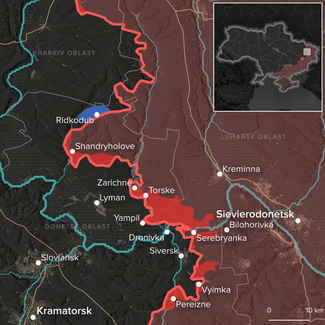
After years of fighting, Russian forces have captured the Kreminna Forests, an extensive woodland area on the northern bank of the Siverskyi Donets River. This was made possible by two breakthroughs: one along the southern bank of the river, from Bilohorivka through Serebryanka and further toward Dronivka; the other along a northern tributary, the Chornyi Zherebets River, advancing from Torske toward Yampil. Ukrainian forces in the forested area likely withdrew across the river via Dronivka to the opposite bank.
By late September, Russian troops had pushed the AFU out of the settlement of Zarichne, adjacent to Torske, and then broke through to Yampil, capturing part of the village.
On the opposite bank of the Siverskyi Donets, Russian forces advanced to Dronivka and reached the northern outskirts of Siversk. Simultaneously, they launched a major offensive on Siversk from the east and south, capturing the village of Vyimka, Fedorivka, and part of Pereizne.
The offensive along the Siverskyi Donets poses a serious threat to the AFU’s hold on Siversk — which lies in a lowland area, while Russian forces control the high ground to the east and north — as well as to the town of Lyman, a key road hub on the river’s northern bank.
Lyman is already nearly encircled: Russian forces have seized the village of Shandryholove, northwest of the town, and reached the road linking Lyman and Izium (the route to Siversk is already cut near Yampil). The only remaining supply line to Lyman runs via river crossings near Raihorodok, on the outskirts of Sloviansk. However, the fixed road and rail bridges there have been destroyed, and the ferry crossing is under frequent Russian airstrikes. Resupplying a large force group north of the river will be difficult.
Still, the river behind the Ukrainian grouping is not only a vulnerability — it also offers defensive advantages. Russian forces can be held on the northern bank for a prolonged period, meaning there is no immediate threat to Sloviansk, even if Lyman falls. However, if Russian troops succeed in capturing Siversk, they would be positioned to resume their offensive along the southern bank.
The Russian assault on Lyman has fractured Ukraine’s forces in the area, particularly the 3rd Army Corps. Units of the 3rd Assault Brigade, along with other corps elements, have been cut off from the main force defending Lyman. Despite this, the 3rd Assault Brigade is attempting to support the town’s defense by attacking the northern flank of the Russian grouping. Ukrainian forces managed to retake the village of Ridkodub, but have so far been unable to advance further into the rear of the Russian forces assaulting Shandryholove, located roughly 10 kilometers (six miles) to the south.
Dnipropetrovsk region
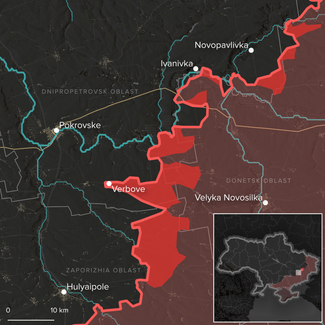
Russian forces have received reinforcements not only in the breakthrough sector near Dobropillia, but also further south of Pokrovsk, at the junction of the Dnipropetrovsk, Donetsk, and Zaporizhzhia regions. In this area, Russian troops are advancing south of the Vovcha River toward the road connecting Hulyaipole — a fortified town and key transport hub in the Zaporizhzhia region — with the settlement of Pokrovske, a major logistical center for the AFU.
The Russian command has redeployed elements of the 90th Tank Division (part of the “Center” grouping) to the southern bank of the Vovcha, after previously operating on the northern bank. The units freed up from the “East” grouping have reinforced Russian troops pushing toward Hulyaipole.
AFU defenses in this sector — having lost several units redeployed to the Dobropillia area — are now operating in a more “mobile” manner: Ukrainian forces are no longer able to maintain a solid, continuous front line and are instead attempting to slow the Russian advance through localized counterattacks.
Although the AFU has managed to briefly retake some settlements, Russian forces have advanced 12 to 17 kilometers (7.5–10.5 miles) across various parts of the sector over the past month. From the Russian-held center of the village of Verbove, the distance to the Hulyaipole–Pokrovske road is only about 10 kilometers (6 miles). Ukrainian sources claim that Verbove was retaken by the AFU in a counterattack, but there is no visual confirmation of this.
Additionally, troops from the 90th Tank Division have crossed the Vovcha near Ivanivka and now threaten to launch an offensive northward toward Novopavlivka, posing a serious risk to AFU units defending the area west of Pokrovsk.
Zaporizhzhia region
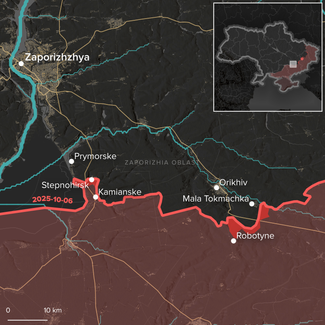
In addition to the threat to Hulyaipole from Russian forces advancing from the east, Ukraine’s defenses in the Zaporizhzhia region are facing several other major challenges.
Russian troops have resumed their offensive toward the city of Orikhiv, which served as a key rear base for the AFU during Ukraine’s summer 2023 offensive. They are advancing on the city from the south, via the ruins of Robotyne, and from the east, through Mala Tokmachka.
Further west, Russian forces are intensifying pressure along the Dnipro River — specifically along the former shoreline of the Kakhovka Reservoir, which dried up after the dam was destroyed in 2023. Russian troops initially captured the settlement of Kamianske and, over the past month, have taken control of the southern parts of Stepnohirsk and the village of Prymorske.
If they reach the Konka River, north of Prymorske, Russian drone operators would gain the capability to strike targets inside the city of Zaporizhzhia itself.
 Eurasia Press & News
Eurasia Press & News



